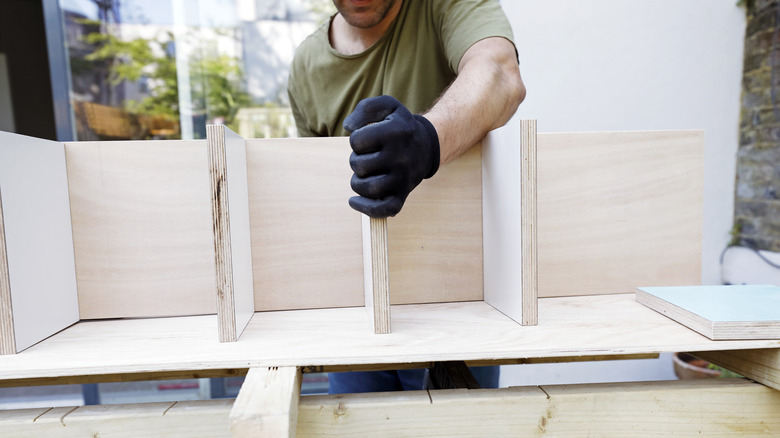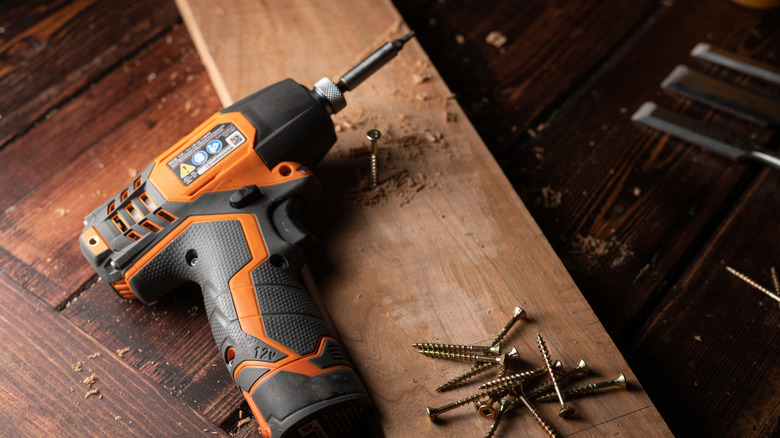The Carpenters' Trick That Makes Working With Imperfect Plywood Shelving Easier
In your DIYs, you may run into imperfect material from time to time. This can potentially be the case with plywood, where, even before you've put too much weight on your shelves, their edges are curved or cupped. Bob Beacham, House Digest's expert carpenter and remodeler, recently gave an exclusive interview on the pros and cons of adding a rabbeted face frame to such imperfect plywood shelves, a potential solution offered by people like @buildersrx on Instagram.
First, what's a face frame? Beacham explained, "A face frame is simply an additional piece of lumber attached to the face — leading edge — of the shelf." Beacham also explained the woodworking nomenclature of a rabbet (sometimes called a rebate). "A rabbet is a step on the edge of a piece of wood," he said. "It's often used to joint one piece of wood into a groove in another. So, a rabbeted face frame is one with a step."
In a plywood shelving project, Beacham said, the advantages of a face frame are adding extra rigidity to the shelf, hiding its unattractive plywood edge, and making the shelf look more substantial. Adding a rabbet to the face frame could provide additional strength to the shelf because it also provides additional glue area. He added that it could also hide the heads of screws that are screwed down into the face frame as fasteners.
Use screws, not nails, on your rabbeted face frame
However, Bob Beacham noted in his exclusive House Digest interview that there are some downsides to this carpenters' trick. Even if you're not trying to save money on lumber, it doesn't come pre-rabbeted, let alone with the right size. "If you have the tools, cutting a rabbet isn't difficult, but you either need a table saw or a router," Beacham said.
Additionally, "As with a lot of 'quick and easy' tricks, it actually takes time and care," Beacham said. Adding a rabbeted face frame, he explained, requires gluing and clamping, allowing you to line up the assembly before using fasteners. Beacham does not recommend using nails here. "Nailing down into the rabbet from above is risky because you might split the wood or miss and have the nail break through," he said. "Nailing through the face frame into the plywood's leading edge is not recommended as it's easy to split the plywood."
"Pre-drilling, then screwing, is more secure and safer," Beacham said, although he noted that this can be tricky when there isn't a lot of wood thickness in the rabbet. Creating a deeper rabbet may be one solution. Beacham provided instructions to measure and mark carefully, glue the rabbeted face frame to the plywood edge, and clamp it securely with at least four clamps. Pre-drill the holes and screw down, being sure to countersink the screws so the heads are below the surface and not removing the clamps until the screws are in place. Then you can fill the holes with wood filler, sand it down, and paint.
Keep plywood straight with proper storage
"If the plywood is curved, [creating a rabbeted face frame is] definitely a workable solution," Bob Beacham said in his exclusive House Digest interview. Although they need to be custom-made, rabbeted face frames are stronger than merely gluing a plain piece of lumber to the shelf. However, Beacham said that the best solution to this problem is to avoid it in the first place by not working with curved plywood.
When you're shopping for plywood, whether that's marine-grade plywood or other varieties, Beacham said, "Go to the store and find a sheet that's flat. If you find one that's bent or curved, don't buy it!" Plywood, Beacham said, should be very rigid unless it's been stored badly. To keep it from warping after you've brought it home from the store, Beacham advised, "Don't keep it anywhere that's damp." Ideally, he recommends laying your plywood flat on the floor until it's needed; if that's not possible, store it as nearly upright as you can.


